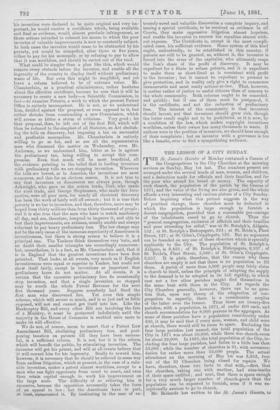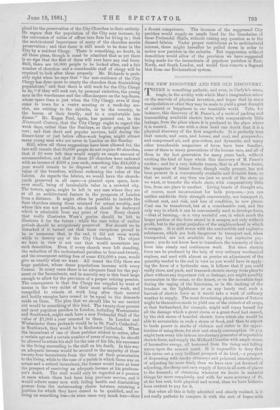THE LESSON OF A CITY SUNDAY.
THE St. James's Gazette of Monday contained a Census of the Congregations in the City Churches at the morning services on Sunday, May 1st last. The numbers present are arranged under the several heads of men, women, and children, and a deduction made for officials and their families, and for the poor who attend for bread or money. The capacity of each church, the population of the parish by the Census of 1871, and the value of the living are also given, and the whole affords a very interesting and curious picture of a City Sunday. Before inquiring what this picture suggests in the way of practical change, those churches must be deducted in which the population is large enough to furnish a decent congregation, provided that a reasonable per-centage of the inhabitants cared to go to church. Thus the "general congregation, exclusive of officials and their families and poor attending for relief," was at St. Botolph's, Aldgate, 152 ; at St. Botolph's Bishopsgate, 224; at St. Bride's, Fleet Street, 127; at St. Giles's, Cripplegate, 126. But no argument can be founded on any one of these churches which is specially applicable to the City. The population of St. Botolph's, Aldgate, is 8,433 ; of St. Botolph's, Bishopsgate, 6,107; of St. Bride's, Fleet Street, 5,060 ; of St. Giles's, Cripplegate, 6,257. It is plain, therefore, that the reason why these churches are empty is not that there is no population to fill them. A parish of more than 5,000 people may fairly claim a church to itself, unless the principle of adapting the supply to the demand is to be adopted in its full rigidity, in which case not a few other parishes might find themselves in the same boat with those in the City. As regards the City Churches generally, however, there can be no ques- tion that, upon any theory of the adaptation of con- gregation to capacity, there is a considerable surplus of the latter over the former. Thus there are twenty-five parishes, with a population, in 1871, of under 400 each, and church accommodation for 8,000 persons in the aggregate. As some of these parishes have a population considerably under 400, it may be said that if every man, woman, and child were at church, there would still be room to spare. Excluding the four large parishes just named, the total population of the City in 1871 was about 50,000, while there was church-room for about 29,000. In 1881, the total population of the City, in- eluding the four large parishes, had fallen to a little less than 53,000; while the number of churches is GI, with accommo- dation for rather mote than 32,000 people. The actual attendance on the morning of May 1st was 3,853, four out of the 61 Churches being closed for repairs. We have, therefore, these two facts to deal with,—first, that the churches, taking one with another, had nine-tenths of their space unfilled ; and next, that there is space enough for a very much larger number of church-goers than the population can be expected to furnish, even if it was ex- ceptionally anxious to go to church. Mr. Richards has written to the Sc, James's Gazette, to
plead for the preservation of the City Churches in their entirety. He argues that the population of the City may increase, by the conversion of suites of offices into flats for living in ; that the architectural importance of many of the churches merits preservation ; and that there is still much to be done in the City by a resident Clergy. There is something, no doubt, in all these pleas, though it must be admitted that as yet there is no sign that the first of them will ever have any real force. Still, there are 50,000 people to be looked after, and a fair number of churches and a considerable staff of clergy will be required to look after them properly. Mr. Richards is prob- ably right when he says that "the non-residence of the City Clergy has done more to empty the churches than diminishing populations," and that there is still work for the City Clergy to do, "if they will seek out, by personal visitation, the young men in the warehouses and the office-keepers on the top-floors, whose spare time is just when the City Clergy, even if they come to town for a vestry meeting or a week-day ser- vice, are retiring to the suburbs, or to the country, to the bosom of their family, and to a comfortable late dinner." Mr. Kegan Paul, again, has pointed out, in the Nineteenth Century, that the City Clergy ought to regard the week days, rather than the Sundays, as their principal har- vest; and that short and popular services, held during the dinner-hour or just before office-work begins, might attract many young men who are never in London on the Sunday.
Still, when all these suggestions have been allowed for, the fact will remain that 50,000 people do not require 60 churches, that if 25 were left they would supply an ample amount of accommodation, and that if these 25 churches were endowed with an income of £500 a year each, something like £24,000 a year would remain to be disposed of out of the nominal value of the benefices, without reckoning the value of the fabrics. As regards the fabrics, we would have the church- yards preserved in all cases—a planted open space, how- ever small, being of incalculable value in a crowded city. The towers, again, might be left in any case where they are at all an architectural feature in the prospects of London from a distance, It might often be possible to include the finer churches among those retained for actual worship, and where this was not possible, no church should be destroyed which is admirable from any point of view. Every church that really illustrates Wren's genius should be left to illustrate it for the future ; while the rare relics of earlier periods should be scrupulously preserved. Nor should we be disturbed if it turned out that these exceptions proved to be so numerous that, in the end, it did not seem worth while to destroy any of the City Churches. The object we have in view is not one that would necessitate any such demolition. Even if every church were left standing, the reduction of the ecclesiastical parishes to four-and-twenty, and the consequent setting free of some £24,000 a year, would give us exactly what we want. All round the City there are huge parishes, whose dense populations increase with every Census. In many cases there is no adequate fund for the pay- ment ot the Incumbents, and in scarcely any is this fund large enough to allow for the provision of a proper retiring pension. The consequence is that the Clergy are crippled by want of means in the very midst of their most arduous work, and compelled to remain at work long after their mental and bodily energies have ceased to be equal to the demands made on them. The plan that we should like to see carried out would be something of this kind. The twenty-four poorest and most populous parishes in London, including Westminster and Southwark, might each have a new Prebendal Stall of the value of £1,000 a year annexed to them. In London and 'Westminster these prebends would be in St. Paul's Cathedral; in Southwark, they would be in Rochester Cathedral. When the incumbent of one of these parishes wished to retire, after a certain age and a certain number of years of service, he should be allowed to retain his stall for the rest of his life, his successor in the living succeeding to the stall on his death. In this way an adequate income would be secured to the majority of these twenty-four incumbents from the time of their presentation to the living, while in the case of a parish in which there was an actual and a retired incumbent, the former would have at least the prospect of receiving an adequate income at his predeces- sor's death. The stall would only be regarded as a pension in cases where there had been long previous service, and it would relieve many men with failing health and diminishing powers from the embarrassing choice between retaining a position for which they have ceased to be qualified, and re- tiring on something less—in some cases very much lees—than a decent competence. The incomes of the suppressed City parishes would supply an ample fund for the foundation of these Prebendal Stalls, without raising any question as to the disused fabrics. Under proper restrictions as to architectural interest, these might hereafter be pulled down in order to endow new parishes in the suburbs. But suppression without demolition would allow of the provision we have suggested being made for the incumbents of populous parishes in East, North, and South London, and would thus remove a flagrant blot from our Ecclesiastical system.

































 Previous page
Previous page